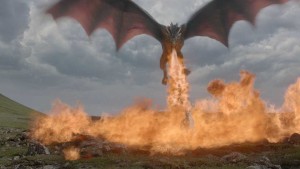 VFX studio Pixomondo has been responsible for creating the fire-breathing dragons of HBO’s hit fantasy series Game of Thrones since the show’s second season. In the show’s fifth season, the dragons are bigger and more complex, creating challenges for the show’s VFX team.
VFX studio Pixomondo has been responsible for creating the fire-breathing dragons of HBO’s hit fantasy series Game of Thrones since the show’s second season. In the show’s fifth season, the dragons are bigger and more complex, creating challenges for the show’s VFX team.
“The dragons started out as kitten-sized babies, then they grew to children, then teenagers – they’ve just become bigger and bigger,” said Sven Martin, visual effects supervisor at Pixomondo. “With that increase in size – and they really are big this year – there’s much more screen space to cover, and that demands a much greater degree of complexity.”
They also get up close and personal with Daenerys, demanding far more computational horsepower.
“We’ve got a lot of close-ups of the dragons, especially when they’re coming into contact with Daenerys, meaning the facial performance has had to become much more evolved,” said Martin. “We’ve really had to refine our facial rig a great deal.
“And of course, having these digital creatures so close to the camera meant a total rebuild of the textures,” he continued. “For this season, all of the individual scales were modelled individually and then attached to the surface itself, meaning the animators could move the skin without them deforming. Overall these kind of enhancements have been huge – in season four we had about 74 textures for the whole dragon. In season five we’re at about 740.”
 With the Pixomondo team in Germany and the show’s production visual effects team either in L.A. or preparing for shoots in Northern Ireland, Spain or Croatia, the only way to create beasts of such complexity and size was to make sure everyone working on the project was in sync.
With the Pixomondo team in Germany and the show’s production visual effects team either in L.A. or preparing for shoots in Northern Ireland, Spain or Croatia, the only way to create beasts of such complexity and size was to make sure everyone working on the project was in sync.
“When working on the same project from different parts of the world like this, it’s important to be connected, and have everyone on the same page – or frame,” said Viktorija Ogureckaja, visual effects producer at Pixomondo. She explained that the team relies on Cospective’s cineSync for remote collaboration. “With cineSync, the sessions have helped to make things so much more efficient. Even though there are hundreds of kilometers separating us from the visual effects supervisor, Joe Bauer and the visual effects producer, Steve Kullback, and we’re living in different time zones, being able to talk about the same material right in front of us – it makes it feel like they’re just a room away. The real-world measurements just don’t matter anymore.”
This global synchronization allows the visual effects team to work across continents on every stage of the dragon creation process – even from the very earliest pre-production brainstorms. “From the initial dragon design by Dan Katcher to scenes blocking, animation and final compositing, cineSync is used to collaborate on all of the production stages of the dragons,” said Martin. “From the concept phase we were doing a lot of cineSyncs together with the client. We share images a lot, even in the process of finding the right reference images in the animal world. We might like a certain texture on the back of a crocodile, for instance, so will want to mark out those specific areas.”
For Martin, the visual nature and interactivity of the software is essential at this stage. Wordy, lengthy descriptions simply won’t do the trick – especially not on the strict deadlines of an episodic television show.
“Not only is writing insufficient to demonstrate abstract ideas, but descriptions in the form of an email would take a lot of time to explain your ideas in an understandable way, and there’s the potential of losing time due to the time zone difference, especially if questions arise,” he explained. “This is where cineSync and features like annotations become very handy. A certain dragon pose might not be working, and you can immediately react on it and say ‘change the tail to this side,’ and so on. It really is like sitting together at one table and drawing with pen on paper.”
“Working without cineSync would be really tough – probably impossible – so we use it heavily,” said Ogureckaja. “We need to make sure that we have our collaborative ideas and solutions synced and that we’re in some sort of communication harmony. It’s one of the key solutions to working on a tight TV schedule like the one we have on Game of Thrones.”





